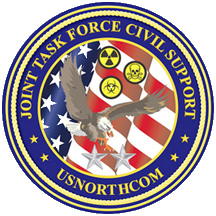
Chemical, biological, radiological and nuclear defense or NBC protection is protective measures taken in situations in which chemical, biological, radiological or nuclear hazards may be present. CBRN defense consists of CBRN passive protection, contamination avoidance, and weapons of mass destruction mitigation.
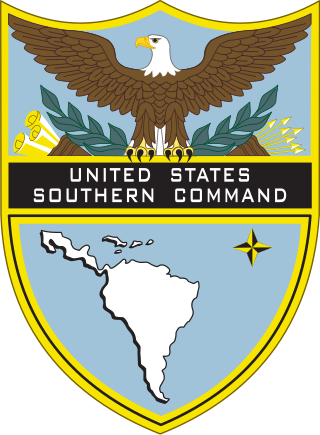
The United States Southern Command (USSOUTHCOM), located in Doral, Florida in Greater Miami, is one of the eleven unified combatant commands in the United States Department of Defense. It is responsible for providing contingency planning, operations, and security cooperation for Central and South America, the Caribbean, their territorial waters, and for the force protection of U.S. military resources at these locations. USSOUTHCOM is also responsible for ensuring the defense of the Panama Canal and the canal area.

The United States Northern Command (USNORTHCOM) is one of eleven unified combatant commands of the United States Department of Defense. The command is tasked with providing military support for non-military authorities in the U.S., and protecting the territory and national interests of the United States within the continental United States, Puerto Rico, Canada, Mexico, The Bahamas, and the air, land and sea approaches to these areas. It is the U.S. military command which, if applicable, would be the primary defender against an invasion of the U.S.

Canada Command was one of the four operational commands of the Canadian Forces from 2006 to 2012. It was responsible for routine domestic and continental operations, such as search and rescue, sovereignty patrol, national security coordination and contingency planning. As an operational formation, Canada Command used resources generated from the three environmental commands of the Canadian Forces: the Royal Canadian Navy, the Canadian Army and the Royal Canadian Air Force. The command was merged into the Canadian Joint Operations Command in October 2012.
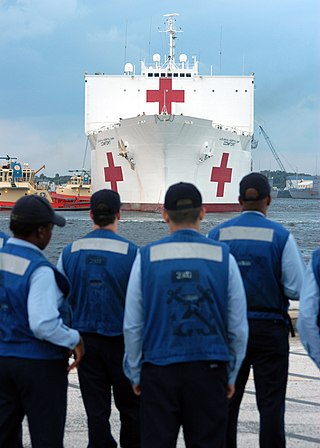
Joint Task Force Katrina was a joint operation between the United States Department of Defense and the Federal Emergency Management Agency created on September 1, 2005, at Camp Shelby, Mississippi to organize relief efforts along the Gulf Coast in the aftermath of Hurricane Katrina. The operation was headed by U.S. Army Lieutenant General Russel L. Honoré. Joint Task Force Katrina took over operations from United States Northern Command that had some elements in place before Hurricane Katrina struck the Gulf Coast.
Joint Task Force-Global Network Operations (JTF-GNO) was a subordinate command of United States Strategic Command whose mission was to: direct the operation and defense of the Global Information Grid (GIG) across strategic, operational, and tactical boundaries in support of the US Department of Defense's full spectrum of war fighting, intelligence, and business operations.

The Special Operations Engineer Regiment (SOER) is a specialised unit of the Australian Army. The regiment forms part of the Special Operations Command. The unit was formed in 2002 as the Incident Response Regiment (IRR), they are deployed to respond to chemical, biological, radiological, nuclear or explosive incidents. The regiment was transferred into the newly raised Special Operations Command in 2003. In 2010 and 2011, its role changed to supporting the army's special forces units, and it was renamed accordingly.

In the U.S., critical infrastructure protection (CIP) is a concept that relates to the preparedness and response to serious incidents that involve the critical infrastructure of a region or the nation. The American Presidential directive PDD-63 of May 1998 set up a national program of "Critical Infrastructure Protection". In 2014 the NIST Cybersecurity Framework was published after further presidential directives.

The Washington National Guard is one of the four elements of the State of Washington's Washington Military Department and a component of the National Guard of the United States. It is headquartered at Camp Murray, Washington and is defined by its state and federal mission. At the call of the Governor, the Washington National Guard will mobilize and deploy during times of state emergency to augment local jurisdictions and responders in their efforts to protect lives and property. The Washington National Guard is also subject to the call of the President of the United States to serve as part of the total U.S. Military force.

Joint Force Headquarters National Capital Region (JFHQ-NCR) is directly responsible for the homeland security and defense of the Washington D.C. area as well as surrounding counties in Virginia and Maryland. Primarily made up of joint military units within the National Capital Region, the JFHQ-NCR assists federal and local civilian agencies and disaster response teams in the event that the capital area's security is or possibly could be breached by acts of terrorism. Officially activated on September 22, 2004, JFHQ-NCR is part of United States Northern Command.

Canadian Special Operations Forces Command is a command of the Canadian Armed Forces. It is responsible for all special forces operations that respond to terrorism and threats to Canadians and Canadian interests around the world.
The Joint Task Force Alaska (JTF-AK), headquartered at Joint Base Elmendorf-Richardson in Alaska is a multi-service command composed of approximately 80 soldiers, sailors, airmen, coast guardsmen and civilian specialists. The task force is a homeland defense component of U.S. Northern Command that coordinates the land defense of Alaska and also coordinates military assistance to civil authorities. The JTF-AK's goals are stated as "detect, deter, prevent and defeat terrorist threats within the Alaskan joint area of operations". The task force also states that is conducts civil support as directed.

Joint Task Force-Bravo is a forward-based expeditionary joint task force operating as U.S. Southern Command's (USSOUTHCOM) lead forward element in the Central America (CENTAM) region to promote stability and security and counter transnational and transregional threat networks (C-T3N). JTF-Bravo operates out of Soto Cano Air Base, Honduras, located 10 miles south of the city of Comayagua and 50 miles north of the capital city of Tegucigalpa.

The 20th CBRNE Command is the United States Army headquarters for defense against Chemical, Biological, Radiological, Nuclear, and high-yield Explosives (CBRNE), headquartered on the site of the defunct Edgewood Arsenal chemical weapons production facility at Aberdeen Proving Ground in northern Maryland.
The United States Marine Corps is tasked by Department of Defense directive to "conduct complex expeditionary operations in the urban littorals and other challenging environments" and "conduct amphibious operations, including engagement, crisis response, and power projection operations to assure access." Before 2006, the Marine Corps was the only branch of the Armed Forces that did not have any of its special warfare elements participating in the United States Special Operations Command (USSOCOM), due to confining its special operations capabilities only for the purpose to the Fleet Marine Force.
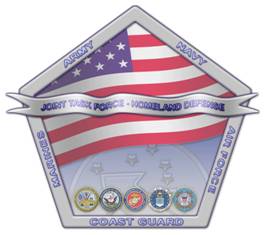
Source: JTF-HD PAO
Joint Elimination Coordination Element (JECE) is a staff element of United States Strategic Command (USSTRATCOM) with the mission of integrating WMD Elimination doctrine into operational plans and joint doctrine, augmenting an existing headquarters to provide elimination planning and command and control expertise, and forming the core of a Joint Task Force for Elimination of WMD (JTF-E).

The AFP Joint Task Force - National Capital Region, known officially as the JTF-NCR or Task Force NCR, is one of the Armed Forces of the Philippines' Joint Task Forces assigned to combating Terrorism-Insurgency and act as support units to the Philippine National Police-National Capital Region in maintaining peace and order within Metro Manila.
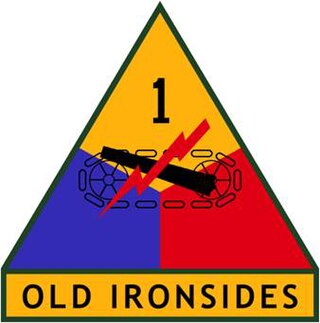
The 24th Press Camp Headquarters (PCH) is an active-duty unit in the United States Army headquartered at Fort Bliss, Texas. The unit consists of 31 public affairs and support personnel and is commanded by a lieutenant colonel assisted by a command sergeant major.

The Joint Cyberspace Command (MCCE), known until 2020 as Joint Cyber-Defence Command (MCCD), is a Spanish cyberspace service of the Defence Staff responsible for planning and carrying out the actions related to cyber defence in networks and information and telecommunications systems of the Ministry of Defense or others that might be entrusted, as well as contributing to the adequate response in cyberspace to threats or aggressions that may affect to the National Defense.
